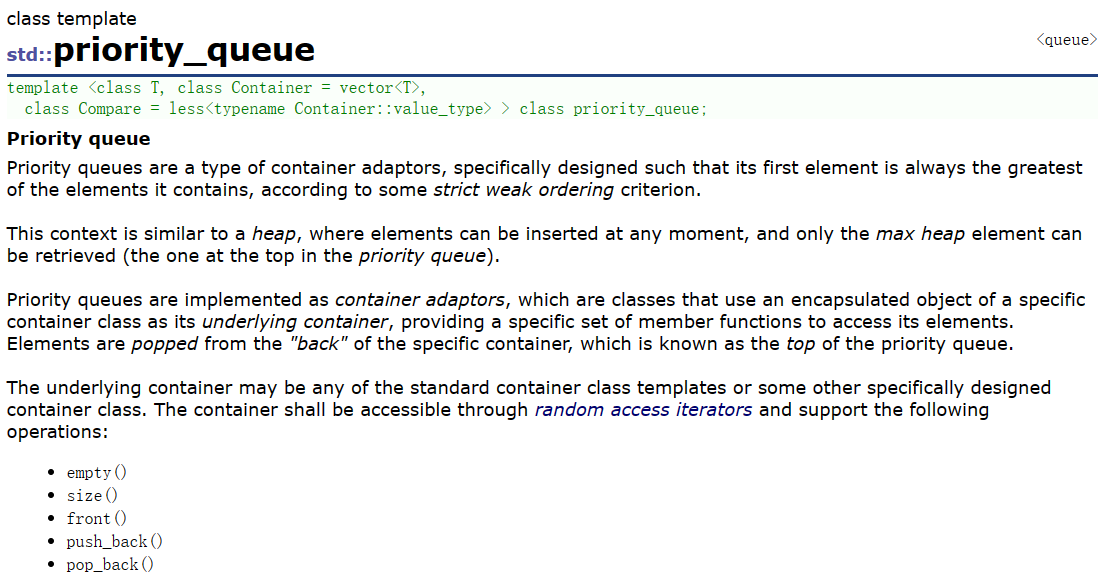priority_queue
priority_queue介绍
pri_que是一个容器适配器,它的底层是其他容器,并由这些容器再封装而来。类似于heap的结构。默认为大堆。

逻辑实现
框架
namespace xty
{
template<class T, class Container = vector<T>, class Compare = less<T>>
class priority_queue
{
bool empty()
{
return _con.empty();
}
size_t size()
{
return _con.size();
}
const T& top()
{
return _con.front();
}
void push(const T& x)
{
_con.push_back(x);
adjust_up(_con.size() - 1);
}
void pop()
{
swap(_con[0], _con[_con.size() - 1]);
_con.pop_back();
adjust_down(0);
}
private:
Container _con;
};
}
调整算法
因为优先级队列是以堆为结构实现的,因此插入删除要保持堆的结构,需要adjust_up()和adjust_down()两个算法。
建堆算法详细参考
adjust_up()
向上调整,由堆底一直调整到堆顶。
void adjust_up(int child)
{
int parent = (child - 1) / 2;
while (child > 0)
{
if (_con[child] > _con[parent])
{
swap(_con[child], _con[parent]);
child = parent;
parent = (child - 1) / 2;
}
else
{
break;
}
}
}
adjust_down()
向下调整,由堆顶一直向下调整直到叶子。
void adjust_down(int parent)
{
size_t child = 2 * parent + 1;
while (child < _con.size())
{
if (child + 1 < _con.size() && _con[child + 1] > _con[child])
{
child++;
}
if (_con[child] > _con[parent])
{
swap(_con[child], _con[parent]);
parent = child;
child = 2 * parent + 1;
}
else
{
break;
}
}
}
仿函数/比较函数
我们观察到库的模板参数给了三个,其中第一个参数是数据类型,第二个参数是模板容器,第三个参数就是仿函数(用户可以自己制定比较规则!),默认为大堆less。
template<class T, class Container = vector<T>, class Compare = less<T>>
接下来我们实现一个比较类:
template<class T>
struct less
{
bool operator() (const T& x, const T& y)
{
return x > y;
}
};
template<class T>
struct grater
{
bool operator() (const T& x, const T& y)
{
return x < y;
}
};
然后我们微调调整函数的逻辑将if的内容改成比较函数:
因为使用方法酷似函数,因此它叫仿函数 !
void adjust_up(int child)
{
Compare com; //实例化比较函数
int parent = (child - 1) / 2;
while (child > 0)
{
if (com(_con[child], _con[parent]))
/*if (_con[child] > _con[parent])*/
{
swap(_con[child], _con[parent]);
child = parent;
parent = (child - 1) / 2;
}
else
{
break;
}
}
}
void adjust_down(int parent)
{
Compare com; //实例化比较函数
size_t child = 2 * parent + 1;
while (child < _con.size())
{
if (child + 1 < _con.size() && com(_con[child + 1], _con[child]))
{
child++;
}
if (com(_con[child], _con[parent]))
{
swap(_con[child], _con[parent]);
parent = child;
child = 2 * parent + 1;
}
else
{
break;
}
}
}
仿函数特性
有了仿函数的功能后,我们可以自己定义比较类型,使程序设计更加灵活。
看下面一段代码:
class Date
{
public:
Date(int year = 1900, int month = 1, int day = 1)
: _year(year)
, _month(month)
, _day(day)
{
}
bool operator<(const Date& d)const
{
return (_year < d._year) ||
(_year == d._year && _month < d._month) ||
(_year == d._year && _month == d._month && _day < d._day);
}
bool operator>(const Date& d)const
{
return (_year > d._year) ||
(_year == d._year && _month > d._month) ||
(_year == d._year && _month == d._month && _day > d._day);
}
friend ostream& operator<<(ostream& _cout, const Date& d)
{
_cout << d._year << "-" << d._month << "-" << d._day;
return _cout;
}
private:
int _year;
int _month;
int _day;
};
void test_priority_queue2()
{
// 大堆,需要用户在自定义类型中提供<<的重载
//priority_queue<Date> q1;
priority_queue<Date, vector<Date>, greater<Date>> q1;
q1.push(Date(2018, 10, 29));
q1.push(Date(2018, 10, 30));
q1.push(Date(2018, 10, 28));
cout << q1.top() << endl;
}
首先这段测试代码结果是唯一的:

而如果我们增加另一种格式的代码呢?
class PDateLess
{
public:
bool operator()(const Date* p1, const Date* p2)
{
return *p1 < *p2;
}
};
class PDateGreater
{
public:
bool operator()(const Date* p1, const Date* p2)
{
return *p1 > *p2;
}
};
void test_priority_queue2()
{
//priority_queue<Date*, vector<Date*>, PDateLess> q2;
priority_queue<Date*, vector<Date*>, PDateGreater> q2;
q2.push(new Date(2018, 10, 29));
q2.push(new Date(2018, 10, 30));
q2.push(new Date(2018, 10, 28));
cout << *(q2.top()) << endl;
}
这段代码如果不写仿函数,结果是不唯一的,因为比较的是指针,重写仿函数后,答案就唯一了!!可以看见,仿函数可以使我们比较数据更加灵活!
构造函数
显然我们没有写构造函数,程序并没有报错,是因为:
- 我们不写构造函数,编译器会默认生成一个。而成员函数是自定义类型,会调用自定义类型的构造函数,所以程序没有问题运行。
- 当我们写了构造函数之后,编译器就不会再默认生成了,需要我们自己写。
迭代器区间构造
因为自己显示写了构造函数,编译器不再默认生成默认构造函数,需要自己再显示补一个默认构造!
//默认构造
priority_queue(){
}
template<class InputIterator>
priority_queue(InputIterator first, InputIterator last)
{
Container _con;
while (first!= last)
{
push(*first);
first++;
}
}
完整优先级队列代码
namespace xty
{
template<class T>
struct less
{
bool operator() (const T& x, const T& y)
{
return x > y;
}
};
template<class T>
struct grater
{
bool operator() (const T& x, const T& y)
{
return x < y;
}
};
template<class T, class Container = vector<T>, class Compare = less<T>>
class priority_queue
{
public:
void adjust_up(int child)
{
Compare com; //实例化比较函数
int parent = (child - 1) / 2;
while (child > 0)
{
if (com(_con[child], _con[parent]))
/*if (_con[child] > _con[parent])*/
{
swap(_con[child], _con[parent]);
child = parent;
parent = (child - 1) / 2;
}
else
{
break;
}
}
}
void adjust_down(int parent)
{
Compare com; //实例化比较函数
size_t child = 2 * parent + 1;
while (child < _con.size())
{
if (child + 1 < _con.size() && com(_con[child + 1], _con[child]))
{
child++;
}
if (com(_con[child], _con[parent]))
{
swap(_con[child], _con[parent]);
parent = child;
child = 2 * parent + 1;
}
else
{
break;
}
}
}
bool empty()
{
return _con.empty();
}
size_t size()
{
return _con.size();
}
const T& top()
{
return _con.front();
}
void push(const T& x)
{
_con.push_back(x);
adjust_up(_con.size() - 1);
}
void pop()
{
swap(_con[0], _con[_con.size() - 1]);
_con.pop_back();
adjust_down(0);
}
priority_queue(){
}
template<class InputIterator>
priority_queue(InputIterator first, InputIterator last)
{
Container _con;
while (first!= last)
{
push(*first);
first++;
}
}
private:
Container _con;
};
}